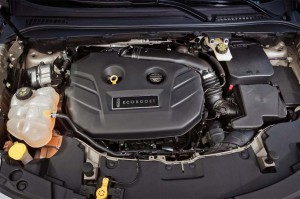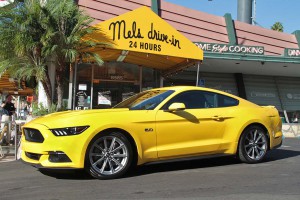When Ford Motor Co. unveiled its 50th anniversary Mustang late last year, it delivered a shock to the market by adding a new turbocharged 4-cylinder engine to its powertrain line-up alongside the pony car’s classic V-8 and V-6 packages.
The EcoBoost engine is expected to have significant appeal to fuel economy-minded buyers, especially those overseas, where Ford will aggressively market the Mustang for the first time. The inline-four also will help Ford prepare to meet increasingly stringent mileage and emissions standards in the U.S., Europe and Asia.
But it is likely to be just a first step in what could become a radical transformation in the powertrain options Mustang buyers will be offered in the not-too-distant future. Various Ford officials tell TheDetroitBureau.com that the range of alternatives that could be required to keep the pony car in the fleet range from even higher-tech turbo and supercharged engines to gas-electric hybrids that can deliver both improved mileage and serious performance simultaneously.
“You will need new technology to achieve both of those goals,” said Dave Pericak, the chief engineer for the 2015 Ford Mustang program, adding that the maker is “committed” to keeping the pony car in its fleet even when the U.S. Corporate Average Fuel Economy, or CAFE, standard jumps to 54.5 mpg in 2025.
(Overseas markets “clamoring” for new 50th anniversary Mustang. Click Here for the full story.)

Ford's 2.3-liter EcoBoost engine is being shared with a number of vehicles, including the 2015 Mustang and the new Lincoln MKC crossover.
Pericak and other Ford officials declined to go on the record discussing specific powertrain technologies they are considering for the Mustang of the future, but the chief engineer confirmed the list is long and will likely go beyond just conventional, internal combustion engines.
That would be a major shift for Mustang which has long been the iconic example of Detroit’s traditional approach to powertrain design. Indeed, while Ford has made some significant upgrades to the 2015 model’s V-6 and V-8 engines, neither yet uses direct injection, a technology today found on even some entry-level vehicles. Nor does the newly redesigned Mustang get fuel-saving Stop/Start technology, which briefly shuts an engine off rather than idling at, say, a stoplight.
The EcoBoost package does at least opt for direct injection and some of the latest in turbocharging technologies.
But that is likely to be only the starting point. Among the various strategies Ford is considering, insiders revealed, could be a downsized engine package for a future Mustang GT. That is certainly a trend gaining traction across the automotive world. The upcoming Mercedes-Benz AMG GT S, for example, will be powered by an all-new twin-turbo 4.0-liter V-8 that is expected to make 456-horsepower and 443 pound-feet of torque.
(Click Here to check out the new Mercedes AMG GT S.)
Even more radical solutions are on the table. Conventional “blowers” have their drawbacks. Superchargers steal a significant amount of power, while turbochargers need to “spool up” before they can deliver a performance boost. That’s the cause of frustrating turbo lag at low RPMs.
Several automakers, possibly including Audi, are reportedly working on e-turbos that use electric motors, rather than exhaust gas, to spin a turbo’s fan blades. But cost and durability remain concerns.
Hybrids and other forms of electric propulsion have typically been focused on energy efficiency, but electric motors reach maximum torque the moment they start spinning, so they have potential performance advantages, as well.
Formula One racers now depend on hybrid assist, and Nissan is reportedly working on a hybrid boost system for its next-generation GT-R supercar. Acura’s reborn NSX will pair a trio of electric motors with a turbocharged V-6.
Might a future Mustang adopt a similar approach? Apparently, that is another real option – though it would require a significant reduction in the cost of today’s lithium-ion batteries, which would also need to become more energy-dense and compact.
(Watch out Ferrari, here comes the Bentley Mulsanne Speed, making 811 pound-feet of torque. Click Here for a closer look.)
Precisely which of these technologies will actually move from the concept stage to the test bench, never mind production, remains to be seen. But while Ford execs wouldn’t discuss individual options, chief engineer Pericak stressed that the Mustang team is “working very feverishly” to address the powertrain challenges the pony car will face for the future.
The good news is that there are plenty of options, but there are an equally many challenges, starting with cost.
“Technology, especially the more exotic, will be needed for (tomorrow’s) performance cars, and they are not cheap,” said Pericak. “We have to figure out how to do these things, and do them affordably.”


Car makers have no choice as they are being blackmailed by Obama and the EPA with an outrageous 54.5 mpg CAFE mandate. No other country in the world has such an ignorant and unrealistic requirement. This is all designed to force EVs on consumers when they are impractical for 99.9999999999999999999 % of society.
This is another example of BAD GOVERNMENT misusing their power to coerce society into adopting a false illusion of environmental improvement at an astounding cost to consumers and it’s a disgrace, IM.
I would go so far as to call the 54.5 mpg CAFE requirement “socialism”. We need to let the market price of fuel dictate what people want to buy. It worked in the early 70’s. Obama thinks we need an “energy policy”, and these ridiculous CAFE standards are part of it. Everyone should write their congressional representative and voice disagreement with these socialistic policies.
why all the change of the motor now ? Why didn’t you as the car maker do that sooner
For those who don’t understand…the auto makers do NOT have any practical means to meet the 54.5 mpg CAFE mandate so they are being forced to build EVs and hybrids to get “credits” towards the outrageous 54.5 mpg mandate pulled from the orifice of politicians. Consumers will pay some where between $5,000-$15,000 more for their cars as a result of this meritless political decree that is not based on any science what so ever.
Instead of using clean Diesels like the rest of the world uses, Obama and the EPA dreamed up the most stringent Diesel emissions standards on the planet so auto makers would produce EVs instead of selling clean Diesels. Obama and the EPA are blackmailing the auto makers and it will cost consumers dearly – all because Obama and the EPA want to increase sales of totally impractical EVs that most of the world can not use.
I don’t think any of these powertrain options are “radical” as Ford has done this before on the Mustang. In the past it has had turbo 4s, very lean V6s and downsized V8s (anyone remember the horrible 4.2L (255ci) knockoff of the 4.9L (302ci)). The natural progression is to some type of hybrid drivetrain but I’d say look for DI adoption first and continuation of eco-boosting. 54.5 might seen high, impossible, idiotic but the same was said about raising CAFE to the current ratings. Never heard it being a socialist thing though.
I do agree with Jorge somewhat on the clean diesels and there lack of usage here in the US.
Many good points, EAJ. I will let the political name-calling wash by me. You are absolutely correct in noting that there has been frantic hand-wringing with every CAFE increase since the original law was passed. It’s not a good standard and could use a rework in terms of how it is measured, etc. The 54.5 mpg target actually works out closer to the mid-40s when credits, corrections, etc., are factored in. It will be hard but do-able. Recall folks said we’d all be driving fours and anemic sixes by now, and that we’d be lucky to hit 60 in 12 seconds. We now have Hellcats and Veyrons and AMGs, and so on, as I have pointed out in several recent stories.
As to the Mustang, in particular, I was surprised they didn’t go for either DI or displacement-on-demand, never mind Stop/Start. Expect those on updates during the current car’s lifecycle.
Paul A. Eisenstein
Publisher, TheDetroitBureau.com